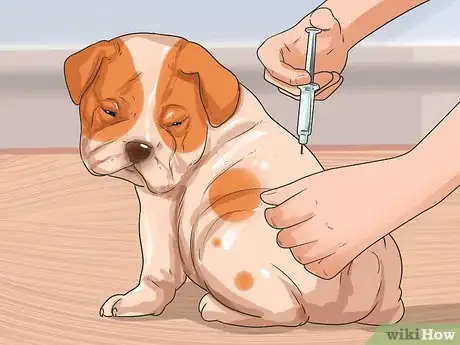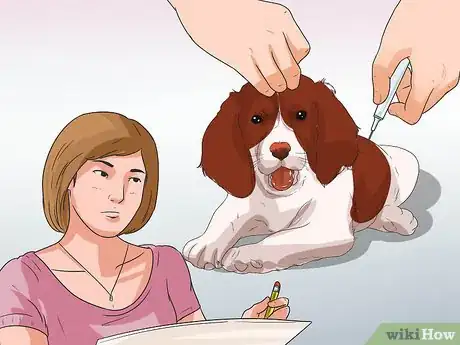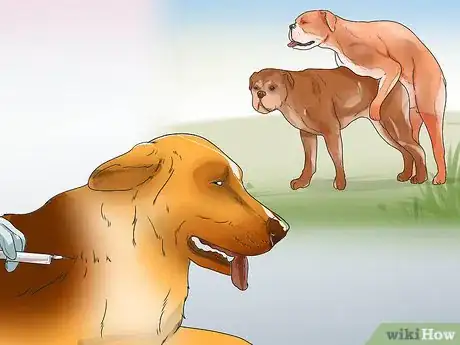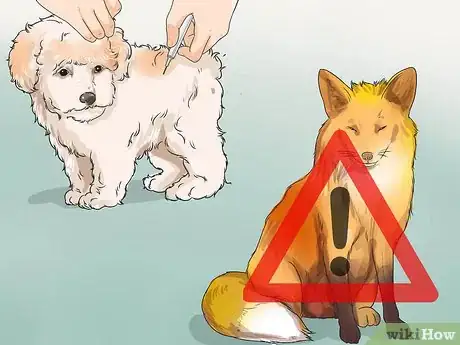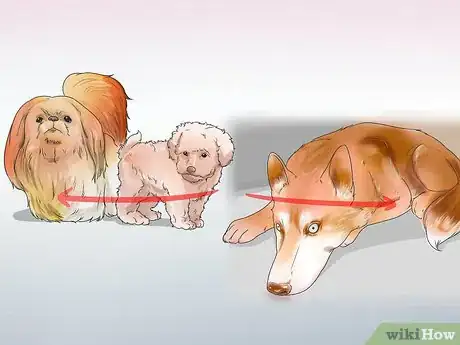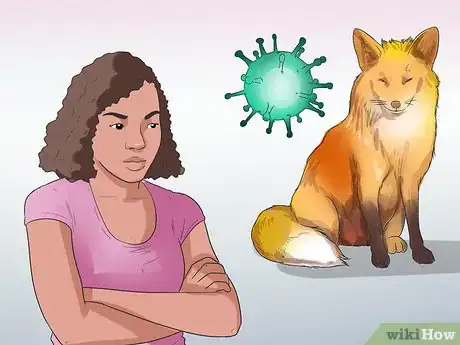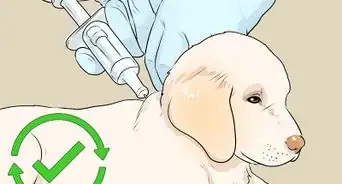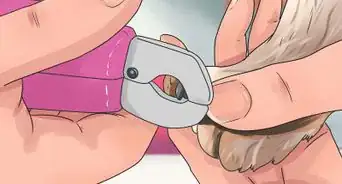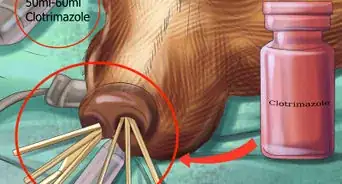This article was co-authored by Cameron Thompsen. Cameron Thompsen is a Dog Trainer and Human Coach, as well as the Owner and Founder of Hope2K9 Foundation. With nearly two decades of experience, she specializes in working with dogs and their owners on behavior issues ranging from severe anxiety, reactivity, as well as aggression and fear-based problems. She works with all dogs at Hope2K9 so that they are fully trained before adoption, and provides lifelong support to dog owners after adoption.
There are 7 references cited in this article, which can be found at the bottom of the page.
This article has been viewed 21,769 times.
Canine distemper is a highly infectious viral disease that affects the gastrointestinal, respiratory, and nervous system of dogs. There is no cure for distemper. While some dogs do recover from the earlier stages, they can be left with neurological disease that leads to seizures in later life. With this in mind, prevention of distemper should be the aim of every owner. Vaccination is the most important step in avoiding the heartache of this heartbreaking condition.[1]
Steps
Vaccinating Against Distemper
-
1Vaccinate a puppy quickly. A puppy should be given a full course of vaccinations as soon as possible.[2] Typically the first dose of vaccination is given from 6- 8 weeks of age, and then every 3 - 4 weeks until the pup reaches 16 - 20 weeks of age.[3]
- When the puppy reaches around 14 months of age it requires a top-up booster vaccination. After that, it will need another booster every three years for the rest of its life.[4]
- Dogs that are most at risk of distemper are those that do not have any immunity to it. Typically these are puppies aged 3 - 6 months, or dogs that have not been vaccinated against distemper and have no natural immunity to this disease.
-
2Keep vaccinations up to date. The mainstay of prevention is vaccination.[5] An effective vaccination is available and all responsible dog owners should make sure their dogs are vaccinated and receive regular booster doses of vaccine. This is especially important given that apparently healthy dogs may be excreting distemper virus, thus putting other dogs at risk but without giving any warning signs.[6]Advertisement
-
3Make sure all breeding dogs are up to date on vaccinations. Breeding bitches should be up-to-date with their distemper vaccination prior to falling pregnant. This helps ensure that they pass on a good level of passive immunity to the pups when the suckle. A nursing bitch produces antibodies which pass via the milk to the puppies - these are known as maternally derived antibodies, and they give the puppy passive protection for the first few weeks of life (typically up to about 6 - 8 weeks of age.) [7]
-
4Be sure to vaccinate dogs that come into contact with wildlife. Be aware that if you have wildlife populations in the area, your dogs may be at increased risk. This is because of the ability of foxes or raccoons to harbor distemper virus and act as a reservoir of infection for domestic dogs. Thus, it is important to get your dog vaccinated.[8]
Keeping a Clean Environment
-
1Disinfect animal areas regularly. It makes good sense to keep food and water bowls clean, not just because of the risk of distemper infection, but as a measure of good hygiene.[9] Most regular household disinfectants kill distemper virus, including a 1:20 dilution of household bleach with water [10]
-
2Clean areas where infected animals have been. Distemper virus in the environment is not particularly hardy, and is destroyed by heat and dry conditions, as well as most common disinfectants. However, it can survive for a few weeks at temperatures just above freezing.[11]
- The most common source of infection is through contact with bodily fluids. This might be through contact with diarrhea or vomit containing the virus, or through the air when the dog sneezes.
- Dogs can become infected if they use contaminated food or water bowls. They can also get infected if they sniff and explore in an environment contaminated with viral particles.[12] This is why the virus is so infectious and why it's so important to have your dog vaccinated.
-
3Keep infected dogs isolated. This means that you should not take an infected dog to a dog park or any area where there are a lot of other dogs.[13] Unvaccinated dogs need to be kept away from dogs with distemper. This includes dogs who have recently recovered from an illness that could have been due to distemper.
- An added complication is that dogs can shed distemper virus for several months after they have recovered from the first stage of the disease. Thus, outwardly they appear fine but they remain an infection risk to other dogs.[14]
- Socializing a dog that is infected with distemper can be hard. If you have another dog that you are absolutely sure is properly vaccinated, then you can have them interact. However, it is always better to be safe than sorry. Dogs do not have a lifelong resistance to distemper once they are vaccinated once. The vaccination must be boosted regularly to keep its effectiveness.[15] If you are in doubt at all, keep the infected dog away from all other dogs.
Dealing With Distemper
-
1Learn about the distemper virus. Distemper is caused by a morbillivirus from the family paramyxovirus. It is highly contagious between members of the dog family and wildlife, such as mink, ferrets, raccoons, skunks, coyotes, and foxes.[16]
-
2Look for the signs of distemper. It is important to understand the symptoms of distemper so that the illness can be treated, and the animal can be isolated, as quickly as possible. Signs of distemper include:[19]
- Fever: One of the first signs is a raised temperature, as the virus multiplies in the body. The fever may make the dog depressed, quiet, and listless. It is likely to go off its food.
- Respiratory signs: These include a cough, with a snotty nasal discharge and a gummy discharge around the eyes.
- Gastrointestinal signs: Next the dog develops vomiting and diarrhea. He is progressively weaker due to a lack of appetite, and fluid loss from the sickness and diarrhea. Some dogs succumb at this point and die, whilst others do recover.
- Neurological signs: These can develop weeks to months after recovery from the respiratory and gastrointestinal signs. The dog may develop seizures, become blind, or become poorly coordinated.
- Hardpad: One of the lasting effects for dogs that survive distemper is that they develop hard pads and nose. This is why the common alternative name for distemper is "hardpad."
-
3Get supportive care. The prognosis for a dog with distemper is not good. Some dogs do survive, but not usually. This is especially true if the dog has the neurological signs of the virus.[20] However, your veterinarian should give the dog treatment to ease any discomfort and eliminate any secondary infections.
- Treatment can include IV fluids, anti-seizure medications, anti-diarrheals, and antibiotics.
- You should also focus on making the dog as physically comfortable as possible. Keep it warm and cozy at home. Shower the dog with love and attention while you still have time with it. Basically, do all that you can to ease its suffering and make the time it has left as pleasant as possible.
Expert Q&A
-
QuestionWhat causes canine distemper?
 Pippa Elliott, MRCVSDr. Elliott, BVMS, MRCVS is a veterinarian with over 30 years of experience in veterinary surgery and companion animal practice. She graduated from the University of Glasgow in 1987 with a degree in veterinary medicine and surgery. She has worked at the same animal clinic in her hometown for over 20 years.
Pippa Elliott, MRCVSDr. Elliott, BVMS, MRCVS is a veterinarian with over 30 years of experience in veterinary surgery and companion animal practice. She graduated from the University of Glasgow in 1987 with a degree in veterinary medicine and surgery. She has worked at the same animal clinic in her hometown for over 20 years.
Veterinarian Canine distemper is caused by a virus belonging to the same family as human measles. The virus is known as the morbillivirus, belonging to the paramyxovirus family of infectious agents.
Canine distemper is caused by a virus belonging to the same family as human measles. The virus is known as the morbillivirus, belonging to the paramyxovirus family of infectious agents. -
QuestionHow long do dogs live with distemper?
 Pippa Elliott, MRCVSDr. Elliott, BVMS, MRCVS is a veterinarian with over 30 years of experience in veterinary surgery and companion animal practice. She graduated from the University of Glasgow in 1987 with a degree in veterinary medicine and surgery. She has worked at the same animal clinic in her hometown for over 20 years.
Pippa Elliott, MRCVSDr. Elliott, BVMS, MRCVS is a veterinarian with over 30 years of experience in veterinary surgery and companion animal practice. She graduated from the University of Glasgow in 1987 with a degree in veterinary medicine and surgery. She has worked at the same animal clinic in her hometown for over 20 years.
Veterinarian Distemper has a range of outcomes including full recovery to death. Many patients fall into a gray area where they recover from the initial disease, but are left with health complications. Of these, the most severe is seizures. However, even with seizures, some dogs live on for years after the initial severe illness.
Distemper has a range of outcomes including full recovery to death. Many patients fall into a gray area where they recover from the initial disease, but are left with health complications. Of these, the most severe is seizures. However, even with seizures, some dogs live on for years after the initial severe illness. -
QuestionHow does a dog get distemper?
 Pippa Elliott, MRCVSDr. Elliott, BVMS, MRCVS is a veterinarian with over 30 years of experience in veterinary surgery and companion animal practice. She graduated from the University of Glasgow in 1987 with a degree in veterinary medicine and surgery. She has worked at the same animal clinic in her hometown for over 20 years.
Pippa Elliott, MRCVSDr. Elliott, BVMS, MRCVS is a veterinarian with over 30 years of experience in veterinary surgery and companion animal practice. She graduated from the University of Glasgow in 1987 with a degree in veterinary medicine and surgery. She has worked at the same animal clinic in her hometown for over 20 years.
Veterinarian Distemper is a viral infection. Much like other viral diseases, such as flu, individuals acquire infection by contact with a virus that has been left behind in the environment. In the case of distemper, infection can be breathed in when a dog meets another infected dog or visits a contaminated environment.
Distemper is a viral infection. Much like other viral diseases, such as flu, individuals acquire infection by contact with a virus that has been left behind in the environment. In the case of distemper, infection can be breathed in when a dog meets another infected dog or visits a contaminated environment.
References
- ↑ http://www.banfield.com/pet-health-resources/preventive-care/vaccinations/canine-distemper
- ↑ Cameron Thompsen. Dog Trainer. Expert Interview. 31 March 2022.
- ↑ http://www.banfield.com/pet-health-resources/preventive-care/vaccinations/canine-distemper
- ↑ http://www.banfield.com/pet-health-resources/preventive-care/vaccinations/canine-distemper
- ↑ Cameron Thompsen. Dog Trainer. Expert Interview. 31 March 2022.
- ↑ http://www.vetstreet.com/care/canine-distemper-parvo-bordetella-and-rabies-vaccine
- ↑ http://www.2ndchance.info/dogdistemper.htm
- ↑ https://www.avma.org/public/PetCare/Pages/Canine-Distemper.aspx
- ↑ Cameron Thompsen. Dog Trainer. Expert Interview. 31 March 2022.
- ↑ http://www.2ndchance.info/dogdistemper.htm
- ↑ http://www.2ndchance.info/dogdistemper.htm
- ↑ https://www.avma.org/public/PetCare/Pages/Canine-Distemper.aspx
- ↑ Cameron Thompsen. Dog Trainer. Expert Interview. 31 March 2022.
- ↑ https://www.avma.org/public/PetCare/Pages/Canine-Distemper.aspx
- ↑ http://www.peteducation.com/article.cfm?c=2+2102&aid=419
- ↑ https://www.avma.org/public/PetCare/Pages/Canine-Distemper.aspx
- ↑ http://www.peteducation.com/article.cfm?c=2+2102&aid=419
- ↑ http://pets.webmd.com/dogs/canine-distemper
- ↑ http://www.2ndchance.info/dogdistemper.htm
- ↑ http://www.banfield.com/pet-health-resources/preventive-care/vaccinations/canine-distemper
About This Article
To prevent canine distemper, make sure to vaccinate your puppy against the disease when it’s 6 to 8 weeks old. After this initial vaccination, you'll need to get it distemper shots every 3 to 4 weeks until it reaches 16 to 20 weeks old. Additionally, make sure your puppy gets a distemper booster when it’s around 14 months old, and continues to get vaccinated against the illness every 3 years. In addition to vaccines, keep your pet’s food and water bowls clean to kill the distemper virus. If your dog is infected, make sure to keep it isolated from all other dogs since the virus spreads easily and quickly. For more tips from our Veterinary co-author, including how to recognize the signs of distemper, keep reading!
